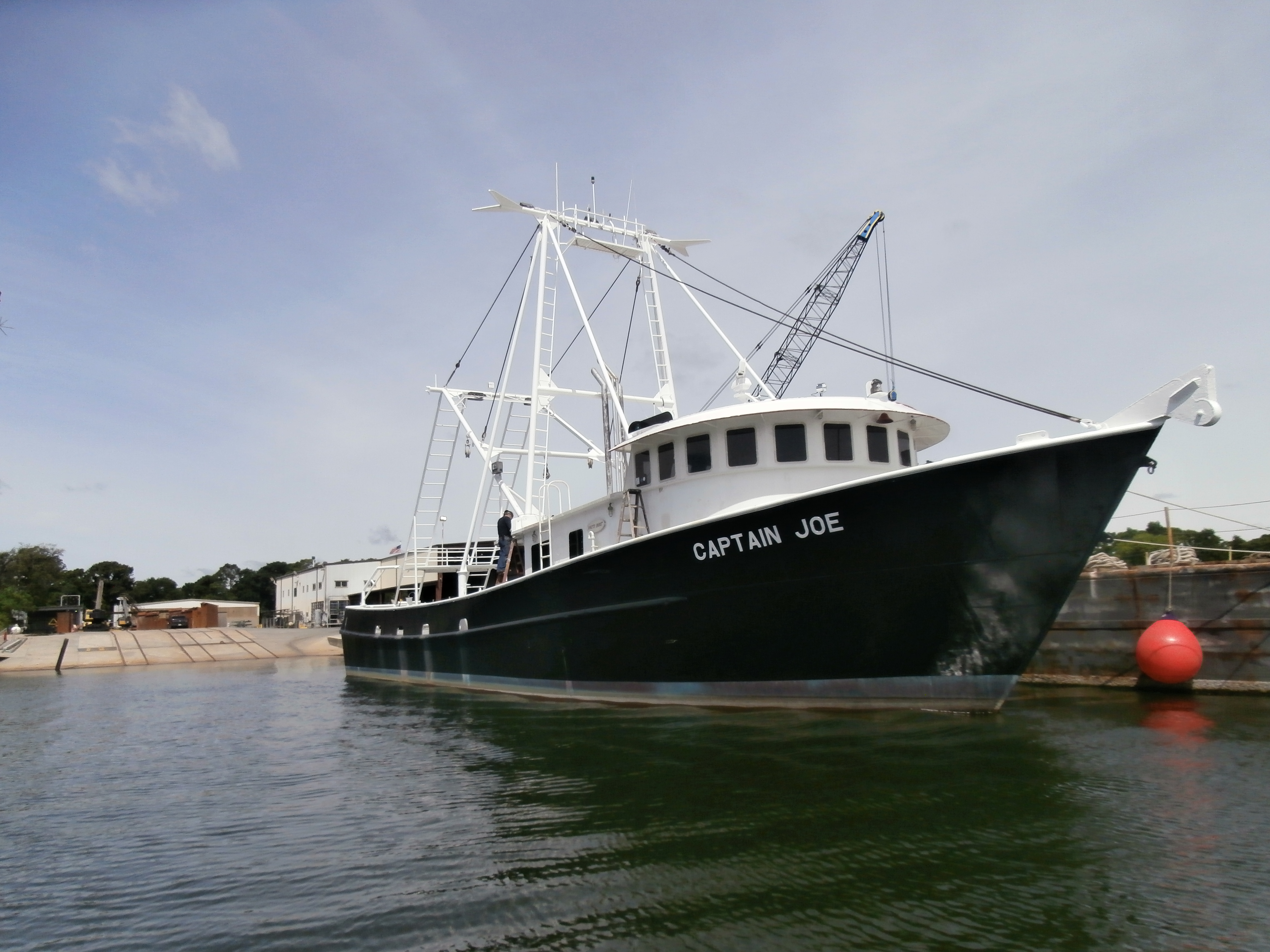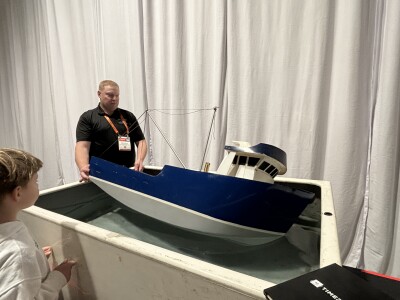Patti Marine in Pensacola, Fla., has been building boats for fishermen all over the USA for 40 years. But the yard’s most recent project is one of its own, a 101-foot shrimp boat, the Captain Joe.
“We started building boats for ourselves,” says Frank Patti Jr., who runs the Patti family’s yard. “We were building boats with longitudinal and transverse framing, which made for a really strong vessel with nice lines. We knew what it took to build a good vessel.”
According to Patti, the transverse frames on the boat areall 5-inch by 3-inch, quarter-inch steel angle, and the stringers are all 2-inch, 3/8ths flat bar.
“We were building our own fleet, you see. The first boat we were building, this guy came down from Kodiak and saw what we were doing, and he crawled all over that boat. He said he’d been stopping at a lot of yards but hadn’t seen anything like what we were doing. He had to have it.”
While the Patti family initially refused to sell, the Alaskan fisherman persisted until he made an offer the family could not refuse.
“We ended up building a bunch of those king crab boats that went up there,” says Patti. The yard also fulfilled its primary role: to build the family’s fleet. The fleet operated through the 1980s and ’90s.
But according to Patti, when fuel prices went up and shrimp prices went down in the late 1990s and early 2000s, the family sold off most of the fleet.
“Then Hurricane Ivan in 2002. That shut us down,” says Patti. “After that, we only kept one boat, the Captain Joe.”
As the coronavirus pandemic wreaks havoc on daily life around the country, the yard continues to operate. “We’re wearing masks and gloves, and we’re taking temperatures,” says Patti. “We have some folks working from home. But we’re still here.”
Patti Marine has had one big project delayed as a result of the virus, but the yard just relaunched the Captain Joe after a massive rebuild.
“We put a five-year bottom on her — blasting, chipping, painting — flushed the coolers, new zincs,” says Patti. “I saved the old outriggers. We put in two new Cummins BT6 95-kW gensets, new winches for the booms.”
The 25-year-old vessel is not the first Captain Joe the family has built. “I think it’s the fifth or sixth,” says Patti. But he notes that this one is probably the last. “This boat is not going to fish again,” he says. “My father wants to keep her docked next to Joe Patti’s Seafood.”
The Captain Joe gets its name from Guiseppe “Joe” Patti, who arrived in the United States in 1918 from Riposto, Italy, a little fishing village on the island of Sicily. Oddly enough he met a young woman, Anna Patane, who had grown up 10 miles away from him in Italy. He married her, and they started a family.
“There was a big Italian community in Pensacola at the time,” says Patti. “They got my grandfather a job on a snapper smack. It was a sailboat. They would sail to Campeche [Mexico] and fish for snapper, and they had a well in the boat to keep the fish alive and bring them back here. They made two-week trips to sail down there, load up and come back. My grandmother didn’t want him to be away all that time. So in 1920 they bought a little boat, the Babe, and they started selling his catch off the front porch.”
Patti notes that the business is still thriving and about to celebrate its 90th anniversary. “Joe Patti’s Seafood was voted the third best seafood market in the country,” he says. The Captain Joe will be a part of that anniversary celebration, helping people understand the Gulf Coast shrimp industry.
The renovation has taken two months. The 101-foot vessel has a 26-foot beam and draws 12.5 feet. She is all steel with nine watertight compartments. As far as gulf shrimp trawlers go, she’s a big boat, and she doesn’t lack for power. Two 425-hp, 6-cylinder Cummins KT-19-M engines propel the sleek vessel through the clear waters of the Gulf of Mexico.
“We used to run 9 knots on the way out,” says 90-year-old Frank Patti Sr., who ran the boat for several years. “She would do 11 knots. And on the way home that’s what I do. I’d run her wide open all the way.”
The starboard engine has a Twin Disc model MG514 reduction gear with 6.0:1 reduction. The port engine has a ZF Model ZF6350 reduction gear on port engine with 5.955:1 reduction. Both turn 32-foot long, 5-inch Aquamet 19 stainless steel intermediate shafts with stainless steel tail shafts, with 64 x 46-inch, four-blade bronze propellers.
The boat’s twin gensets power systems that include an 9,000-ton freezer hold, split into two compartments. Patti calls the Captain Joe a “Cadillac shrimp trawler.” The wheelhouse electronics mark the era the vessel fished in. The boat’s Furuno LC90MK11 and LP1000 loran C units are purely decorative now. On Jan. 7, 2010, the Department of Homeland Security officially turned off the loran system that guided seafarers for more than four decades.
Other electronics include a Furuno FR8050D radar and a Furuno FCV color video depth sounder, as well as two VHFs, an Icom and a Yaesu. Other communications equipment includes a Sea222, single sideband radio, and Standard Horizon LH10 loudhailer. GPS and satcoms were just starting to come online when the Captain Joe stopped fishing.
On deck, the vessel has a double drum McElroy 505-6BD winch powered by a hydraulic motor with 10-inch catheads, and a single trynet winch powered by a 5-hp electric motor with stainless steel cable and level winds, and two new hydraulic boom winches.
With her full complement of trawl doors and 51-foot shrimp nets, the boat is almost ready to fish. She just needs some updated navigation equipment, and a captain and crew. While the vessel has a captain’s stateroom and crews quarters with double bunks for four, the usual crew is a captain plus two.
When the boat was fishing commercially, she would make trips of up to six weeks.
“They had a brine freezer on deck,” says Patti. “They would IQF the shrimp and put them in sacks that held about 30 pounds.” According to Patti the boat usually took a crew of six on those trips.
“After we sold all our boats, this one became a skimmer trainer for other boats during the BP oil spill.” Even if the price of shrimp went up, Patti is pretty sure his father would not fish. “He wants her right there,” he says. “More than a few people have wanted to buy her. They’ve offered him good money. But he doesn’t want to sell.”
The vessel means a lot to owner Frank Patti Sr., who keeps the boat nestled at the wharf near his fish market. “She’s named after my daddy,” Patti Sr. says. “We get upwards of 2,000 customers a day on a slow day, and people take a lot of interest in her. I think it’s the most photographed boat in the country.”
Frank Patti Jr. has one idea that involves the Captain Joe dipping a net again. “I’d like to take people out on evening cruises, food and drinks, and we could tow a little trynet for a little while and bring it up, so people could see what’s down there.” Not that they would catch their dinner, he notes.
The new role of the recently restored Captain Joe is not to bring home shrimp, but to educate consumers, letting them know what goes into the seafood they enjoy — and what it’s really worth.
“It’s not fish ye’re buying — it’s men’s lives,” as Sir Walter Scott wrote in 1816.







